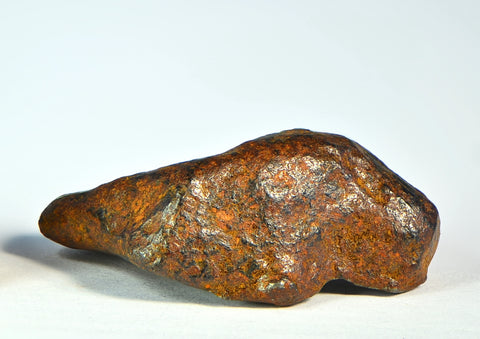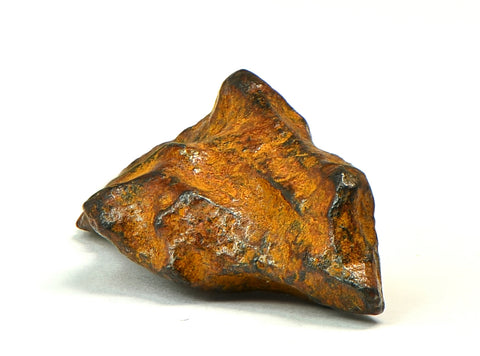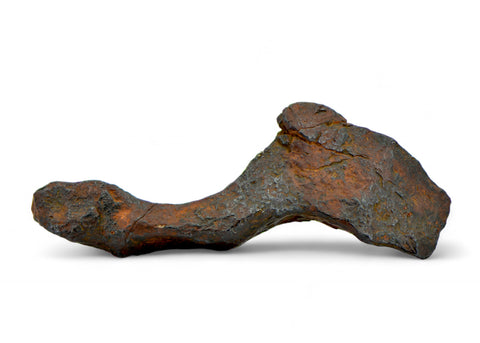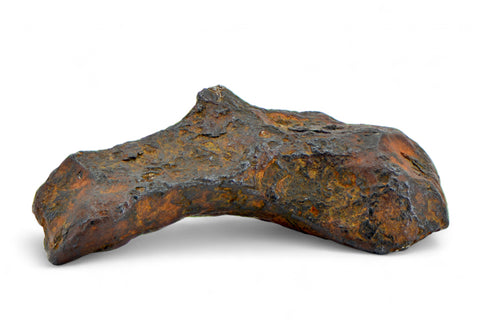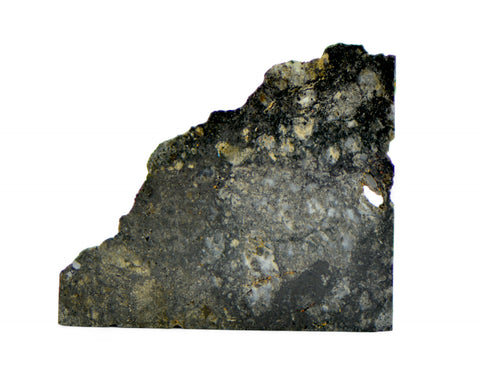1.8g Cranfield Chondrite H 3-5 Meteorite Slice I Mississippi Witnessed Fall 2022
On Offer: An amazing 1.8 gram slice of the Cranfield chondrite meteorite with pristine fresh fusion crust on exterior of the specimen.
Name: Cranfield
Classification: H3-5
Fall: YES
Date Fell: April 27th, 2022
Location: Cranfield, Mississippi
Description: This 1.8 gram slice of the Cranfield H 3-5 chondrite meteorite has pristine fresh fusion crust on its exterior and is an exceptional collection specimen. Classified as an H 3-5, it offers a spectrum of equilibration. This Cranfield meteorite specimen offers both unequilibrated (3) and equilibrated (4 and 5) chondritic petrologies in a single meteorite. The parent body of H chondrites is thought to be the S-type asteroid 6 Hebe, and is composed of mostly bronzite a type of orthopyroxene.
I was fortunate enough to have hunted and recovered meteorites from this recent fall. It was deep in a rural part of Mississippi near the Natchez State Park. The heat was intense and the woods dangerously thick and full of poisonous snakes. The mosquitos and sumac made it even worse. The locals were extremely friendly and helpful, but absolutely not fooling around when it came to trespassing. It was a week I will never forget, with friendships made and more sweat than I though physically possible!
Here are some pics from this meteorite adventure in the deep South...






History: On April 27, 2022, at 8:03 a.m. multiple eyewitnesses from Arkansas, Louisiana, and Mississippi reported a bolide and sonic booms. Doppler radar data revealed falling meteorites approximately 24 km east of the city of Natchez, Mississippi. The radar reflectivity data overlay rolling hills of dense woodland interspersed with open flat residential areas. Dark-flight modeling suggested meteorites landed both north and south of the divided four-lane U.S. Hwy 84E, next to the sparsely populated subdivision called Cranfield.
What you get: A 1.8g meteorite specimen as shown, shipping/storage membrane box, and signed Certificate of Authenticity.
SEE OFFICIAL METEORITICAL BULLETIN DATABASE ENTRY BELLOW
| Cranfield | |||||||||||||||||||||||||||||||||||||||
|---|---|---|---|---|---|---|---|---|---|---|---|---|---|---|---|---|---|---|---|---|---|---|---|---|---|---|---|---|---|---|---|---|---|---|---|---|---|---|---|
| Basic information |
Name: Cranfield This is an OFFICIAL meteorite name. Abbreviation: There is no official abbreviation for this meteorite. Observed fall: Yes, confirmed fall Year fell: 2022 Country: United States Mass: 597 g |
||||||||||||||||||||||||||||||||||||||
| Classification history: |
This is 1 of 90 approved meteorites classified as H3-5. [show all] Search for other: , H chondrites (type 3), Ordinary chondrites, and Ordinary chondrites (type 3) |
||||||||||||||||||||||||||||||||||||||
| Comments: | Approved 28 Jul 2022 | ||||||||||||||||||||||||||||||||||||||
Writeup |
Writeup from MB 111:
Cranfield 31°33’06.1"N, 91°11’36.6"W Mississippi, United States Confirmed fall: 2022 Apr 27 Classification: Ordinary chondrite (H3-5) History: (M. Fries): On April 27, 2022, at 8:03 a.m. CDT (1303 GMT) multiple eyewitnesses from Arkansas, Louisiana, and Mississippi reported a bolide and sonic booms (AMS Event 2022-2591). Doppler radar data revealed falling meteorites approximately 24 km east of the city of Natchez, Mississippi. The radar reflectivity data overlay rolling hills of dense woodland interspersed with open flat residential areas. Dark-flight modeling suggested meteorites landed both north and south of the divided four-lane U.S. Hwy 84E, next to the sparsely populated subdivision called Cranfield. On April 30, 202,2 Linda Welzenbach Fries and Marc Fries recovered the first two meteorites N1 (41.31 g) and N2 (37.65 g), within the center of the calculated strewn field, 16.9 km east of Natchez, on the shoulder (31°33’06.1"N 91°11’36.6"W) and median (31°33’08.9"N 91°11’25.9"W) of U.S. Hwy 84E. The first stone (N1) remains with the finders. The second stone (N2) is subdivided to provide the required deposit material. Both stones were collected cleanly and prior to rain. On May 1st at around 9:07 a.m. Matthew Stream and Roberto Vargas discovered a meteorite that had hit U.S. Hwy 98/84E (31.550129° -91.206338°, WGS84). This stone is estimated at approximately 250 g in total mass, but is broken into many pieces, recovered over two days. Two pieces from this stone were donated to Cascadia for thin section preparation. Physical characteristics: Physical Characteristics: (L. Welzenbach Fries): N1 is a 41.31 g lozenge-shaped stone with 90% fusion crust. A small area of broken crust (where it was sitting on the ground) shows a mottled dark-gray matrix with irregular, millimeter-sized lighter grains, clasts and few chondrule fragments with bright, unoxidized finely disseminated metal. Fusion crust is matte black with some chondrule outlines. N2 is a 37.64 g fragment, roughly rectangular in shape and only 50% fusion crust. The exposed interior sheds particles easily, is finely fractured and reveals a dark gray matrix with breccia clasts ranging from millimeters to centimeters in size. Clasts are light gray, irregularly shaped with poorly defined margins. The surrounding mottled matrix contains millimeter-sized irregularly shaped grains and chondrule fragments. Petrography: (D. Sheikh, M. Hutson, A. Ruzicka, Cascadia): Petrographic and geochemical data were obtained on sample CML 1526 in the Cascadia collection. The first two recovered samples N1 (41.31g) and N2 (37.65 g) were imaged using X-ray computed tomography by S. Eckley at JSC. Total mass of recovered samples is at least 596.83 g (see Samples), but another 500+ grams has been reported through social media but with actual masses and locations unsubstantiated. Regarding the main mass: 122 g fragment is the largest confirmed mass found to date. It is held by Roberto Vargas and Matthew Stream. A notable distinction in color between two lithologies (lighter and darker in color) is observed in thin section in transmitted light. The light lithology displays a chondritic texture with uneven chondrule-matrix integration. Many chondrules can be discerned, with a few having relatively sharp edges. Abundant large (<= 600 μm) metal (with scalloped edges) and sulfide grains are visible; both contain silicate inclusions. Abundant feldspathic-chromite assemblages are also observed. Secondary sodic feldspar (Av. ~20 μm across), chlorapatite, and merrillite are present. The dark lithology displays a brecciated texture composed largely of a texturally and compositionally heterogeneous assemblage of well-defined chondrules (Av. diameter 444±177 μm, n=26) and sub-rounded to angular isolated mineral grains and lithic fragments (both zoned and unzoned) within a fine-grained matrix containing silicates, Fe-Ni metal, troilite, and merrillite. Most chondrules contain a turbid, devitrified mesostasis, although a few chondrules preserve a primary glassy mesostasis. Red-brown spinel grains are present in two chondrules. In BSE imaging, abundant zoned olivine grains are present, along with Mg-rich olivine and pyroxene, and numerous micro-faults. Geochemistry: (M. Hutson, D. Sheikh, A. Ruzicka, Cascadia): Light lithology: Olivine Fa18.3±0.2, N=19; Low-Ca pyroxene Fs15.9±0.1Wo1.1±0.2, N=18. Dark lithology: Olivine Fa17.2±8.1 (Fa ranges from 0.5 to 35.6, with median Fa=18.4), N=45; Low-Ca pyroxene Fs11.6±5.5Wo0.8±0.4 (Fs ranges from 0.7 to 16.9, with median Fs=15.6), N=28. Aluminous spinel: Mg# (100*Mg/(Mg+Fe)) = 69.9±4.0 Cr# (100*Cr/(Cr+Al)) = 0.47±0.21, N=4. Classification: Ordinary chondrite (H3-5). The texture and chemistry of the light lithology is consistent with an H5 ordinary chondrite. For the dark lithology, the chemistry and the presence of devitrified mesostasis in most chondrules, but the preservation of primary glassy mesostasis in some chondrules suggests a moderate subtype between 3.4-3.6. Specimens: Type specimens-Cascadia received 7.1 g of material, and after thin section preparation, holds 5.7 g in six pieces, as well as 2 polished thin sections and material in an epoxy butt. LPI (XSPACE) recovered 8.3 g and received 8.68 g from Linda and Marc Fries. Confirmed samples from finders: Linda Welzenbach Fries and Marc Fries, 41.31 g and 28.96 g; Roberto Vargas and Matthew Stream, 314 g; Raymond Borges and Ily Valenzuela, 13.9 g; Michael Kelly, 54.3 g; Rob Keeton, 12.5 g; Ashley and John Humphries, 0.1 g; Mark Lyon, 5.6 g; Jason Whitcomb and Howard Lewis, 4.5 g; Steve Arnold, 6.3 g; Cameron and Jody Smith, 10.8 g; L.A. Boltryk, 3.2 g; Tasha Lashea, 0.7 g; Sonny Clary and Loren Mille, 76.58 g. |
||||||||||||||||||||||||||||||||||||||
| Data from: MB111 Table 0 Line 0: |
|
||||||||||||||||||||||||||||||||||||||
We Also Recommend








